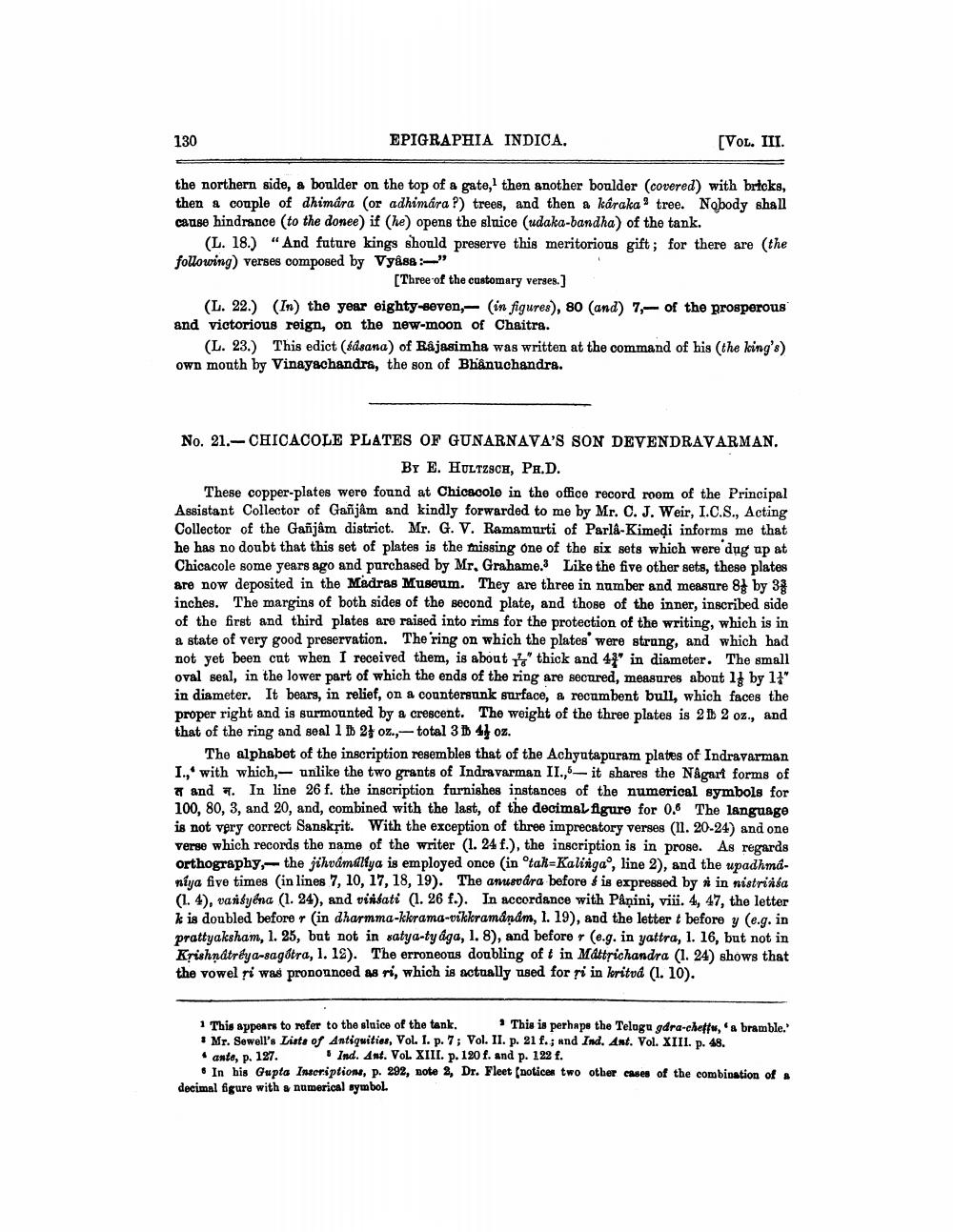________________
130
EPIGRAPHIA INDICA.
[VOL. III.
the northern side, a boulder on the top of a gate, then another bonlder (covered) with brteks, then a couple of dhimára (or adhimára ?) trees, and then a karaka tree. Nobody shall cause hindrance (to the donee) if (he) opens the sluice (udaka-bandha) of the tank.
(L. 18.) "And future kings should preserve this meritorious gift; for there are the following) verses composed by Vyåse "
[Three of the customary verses.] (L. 22.) (In) the year eighty-seven,- (in figures), 80 (and) 7,- of the prosperous and victorious reign, on the new-moon of Chaitra.
(L. 23.) This edict tdsana) of Râjasimha was written at the command of his the king's) own mouth by Vinayachandra, the son of Bhanuchandra.
No. 21.-CHICACOLE PLATES OF GUNARNAVA'S SON DEVENDRAVARMAN.
By E. HULTZSCH, PA.D. These copper-plates were found at Chicacole in the office record room of the Principal Assistant Collector of Gañjâm and kindly forwarded to me by Mr. C. J. Weir, I.C.S., Acting Collector of the Gañjam district. Mr. G. V. Ramamurti of Parla-Kimedi informs me that he has no doubt that this set of plates is the missing one of the six sets which were dug up at Chicacole some years ago and purchased by Mr. Grahame. Like the five other sets, these plates are now deposited in the Madras Museum. They are three in number and measure 8t by 33 inches. The margins of both sides of the second plate, and those of the inner, inscribed side of the first and third plates are raised into rims for the protection of the writing, which is in a state of very good preservation. The ring on which the plates' were strong, and which had not yet been cut when I received them, is about a thick and 44" in diameter. The small oval seal, in the lower part of which the ends of the ring are secured, measures about if by 13" in diameter. It bears, in relief, on a countersunk surface, a recumbent bull, which faces the proper right and is surmounted by a crescent. The weight of the three plates is 2 b 2 oz., and that of the ring and seal 1 2 oz.,- total 3 i 41 oz.
The alphabet of the inscription resembles that of the Achyutapuram plates of Indravarman I... with which, unlike the two grants of Indravarman II., it shares the Någart forms of 77 and . In line 26 f. the inscription furnishes instances of the numerical symbols for 100, 80, 3, and 20, and, combined with the last, of the decimal figure for 0.6 The language is not very correct Sanskřit. With the exception of three imprecatory verses (11. 20-24) and one verse which records the name of the writer (1. 24 f.), the inscription is in prose. As regards orthography, the jihvámiliya is employed once (in otak-Kalinga", line 2), and the upadhmaniya five times (in lines 7, 10, 17, 18, 19). The amustára before f is expressed by * in nistrinsa (1. 4), vanityéna (1. 24), and visisati (1. 26 f.). In accordance with Panini, viü. 4, 47, the letter k is doubled before r (in dharmma-kkrama-vikkramanám, 1. 19), and the letter t before y (e.g. in prattyaksham, 1. 25, but not in satya-tyága, 1. 8), and before r (e.g. in yattra, 1. 16, but not in Krishndtriya-sag&tra, 1. 18). The erroneous doubling of t in Mattrichandra (1. 24) shows that the vowel ri was pronounced as ri, which is actually used for p in loritvd (1. 10).
1 This appears to refer to the sluice of the tank. This is perhaps the Telugu gdra-chett, a bramble. * Mr. Sewell's Lista of Antiquities, Vol. I. p. 7; Vol. II. p. 21 f.; and Ind. Ant. Vol. XIII. p. 48. • ante, p. 127.
Ind. Ant. VoL XIII. p. 120 f. and p. 122 f. . In his Gupta Inscription, p. 292, note 2, Dr. Fleet (noticed two other cases of the combination of a decimal figure with s numerical symbol




